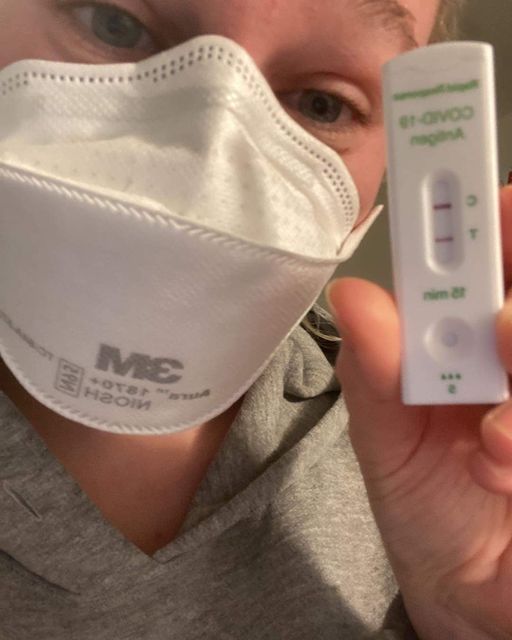When Stephanie Berry woke up Tuesday morning with a headache and a scratchy throat, she quickly reached for one of her at-home COVID-19 rapid antigen tests.
“The kids had rapid tests, so I (took) one up my nose,” the 27-year-old mother of four told Global News. “It came back negative, so I thought, ‘No big deal.’”
But as the day went on, the Kemptville, Ont., resident said she started to feel worse. So she decided to reach for another test.
This time, Berry said, she decided to take a saliva sample after reading about others using the rapid test swabs on their throats and inside their nasal passages.
Berry swirled the swab around each side of her mouth five times. Then she did the same in her nose.
“It came back positive within a minute. It was so fast,” she said. “I am so glad I didn’t go to the store, I could have infected so many people.”

Stephanie Berry testing positive for COVID-19.
There is early evidence a throat swab could be more effective at detecting the Omicron variant but experts are torn on whether people should be using at-home rapid test kits for that purpose.
A small real-world pre-print study, published Jan. 5, looked at two at-home antigen testing kits, which used nasal swabs, and found they, indeed, “lagged” when it came to detecting some Omicron infections during the early period of disease when compared with PCR saliva tests.
Dr. Eric Feigl-Ding, an epidemiologist based in Washington, D.C., explained why a throat swab might be able to give you a more accurate result.
“If you swab your throat, mouth, saliva in addition to your nose, you will actually find more Omicron,” he explained.
Omicron can also be detected a day earlier in the throat than through a sample from your nose, Feigl-Ding added.
“Omicron replicates very differently in the upper respiratory tract than say, Delta,” Feigl-Ding said.
“The studies from Hong Kong, for example, found it replicates in your upper bronchial tubes 70 times more than the original variants but it replicates in your lung slower than the original variant.”
In late December 2021, data out of Cape Town also revealed that testing through the nose may be “suboptimal” for the Omicron variant. The study looked at both Delta and Omicron COVID-19 patients and found those with Omicron had “higher viral shedding in saliva.”

Should I do a throat swab with an at-home rapid test?
Canadian and U.S. health regulators are not recommending swabbing your throat using at-home tests for now, but Feigl-Ding says they need to be able to quickly adapt their guidance as the virus changes.
“Government agencies need to realize this virus moves much faster than their slow committee review systems,” he said when asked about the hesitation from officials.
“It’s a matter of moving at the speed of the pandemic and following the science.”
The U.S. Food and Drug Administration has noted safety concerns and only recommends a throat swap be taken by a professional.
At-home test kits should be used by following the instructions, the agency said Wednesday.
Here, Health Canada has approved package inserts for at-home kits that say the rapid tests can be performed using anterior nasal swabbing or deep nasal swabbing.
When asked by Global News, the public health agency wouldn’t say if it would be making new recommendations.
“(Health Canada is) bound by regulations and bureaucracy. You know, they have to go through a million meetings before they can change anything,” said Toronto ER physician Dr. Kashif Pirzada, who does think the recommendation will shift soon enough.
“I think it’s pretty established now after a month. Swabbing the throat I think should probably be standard now.”
Feigl-Ding said if you are going to try a throat swab at home, there are a few key things to remember.
“Don’t eat or drink anything at least 30 minutes prior to testing,” he explained, adding that when you take the sample, you should try to put the swab to the arches of your throat.
“You can swab your nose afterwards (as well),” he said.
Berry said she watched videos out of the U.K. to learn how to swab for saliva. There, the government has moved forward with promoting nose and throat testing.
She said she is relieved she was able to catch her COVID-19 case quickly and keep her four kids out of daycare and her firefighter husband home.
He is now awaiting the results of a PCR test.
“The nurse at the COVID (centre) said to him Omicron is detected in the throat first,” she said.
“I am worried about how many people have tested in their nose and gone around thinking it is a regular cold.”
© 2022 Global News, a division of Corus Entertainment Inc.








More Stories
Global measles cases nearly doubled in one year, researchers say
How to make conversations with aging parents a little less awkward | CBC Radio
N.S. mom calls for better ultrasound access after private clinic reveals twins | Globalnews.ca